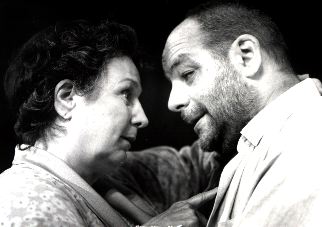Canadian Theatre Encyclopedia
Encore une fois, si vous le permettez

(photo: Pierre Desjardins)
Drama in one long act by Michel Tremblay, premiered at Théâtre du Rideau Vert, August 6, 1998, directed by André Brassard, with Rita Lafontaine and André Brassard, lighting by Claude Accolas, costumes by François Barbeau, set by Richard Lacroix (subsequently presented on tour and at Théâtre Français de Toronto). Subsequently premiered in English, October 1, 1998, translated by Linda Gaboriau as For The Pleasure of Seeing Her Again, directed by Gordon McCall with Nicola Cavendish and Dennis O'Connor. A national tour, a co-production of Centaur Theatre and Canadian Stage, covered the 1999/2000 season including Belfry Theatre, Arts Club Theatre among others. Nicola Cavendish won the Montreal English Critics Circle Award for her performance. The same production was performed at the Arena Stage, Washington DC, in the fall of 2000. The play also won a Chalmers Award and a Dora Mavor Moore Award.
Virtually predestined to be a hit, the opening of this work celebrated both the 50th anniversary of the company presenting it and the 30th anniversary of Tremblay's first professional work, Les Belles-Soeurs, being presented there. It was also a celebration of the union of three magnificent artists: Tremblay, his director Brassard and actor Lafontaine who had begun their careers, virtually simultaneously, with that first play.
But, just as important, it was also a coming together of Tremblay the playwright and Tremblay the novelist/essayist as it presented, for a good look at last, the author's mother, who had haunted all of his works from the start of his career.
The play is simplicity itself: mother and son reliving important and mundane conversations throughout their lives together; conversations that invigorated, exasperated, delighted and inspired the son to go into a career which, at that time - the 1960s - was considered not much better than a hobby. The central tragedy of the play - and the optic through which the work must be examined - is the premature death of Tremblay's mother from cancer, a half-decade before his career as the country's leading playwright could be launched. The play, tinged with regret, allows playwright and mother to reconcile to his choice of career.
The conversations, all of which give centre stage to the mother, are often hilarious, revolving around her versions of stories that have become part of the Tremblay mythos: her love of hokey French literature, her gossip about relatives, her hugely exaggerated re-enactments of moments in the family's history. The function of the narrator/son is one, mostly, of listening and cajoling this phenomenally entertaining figure into talking.
The play concludes with a catharsis - a wondrous theatrical cheat - that, by itself, should inscribe the play not only on the list of this writer's finest, but also as one of the most exciting and touching plays in Canadian theatrical literature and one of those rare works which celebrates the mother-son relationship.
Critical reaction was unanimously positive, particularly for Rita Lafontaine who gave the performance of a lifetime in a role that was written for her and which she inhabited utterly. Initial audiences shrieked with laughter at the antics of a character with whom they were familiar and wept openly at the loving tribute Tremblay paid to his mother. A refreshingly uncomplicated and lucid work. Tremblay is on the record as saying that he wrote it in three days.
Commentary by Gaetan Charlebois
Last updated 2013-06-14

